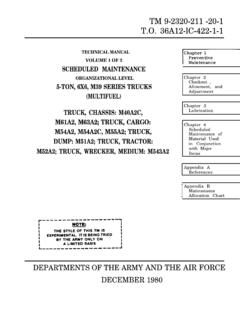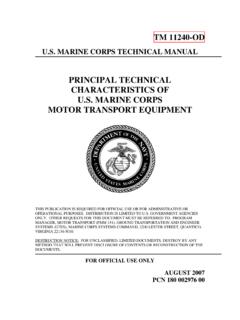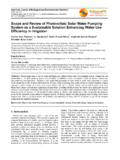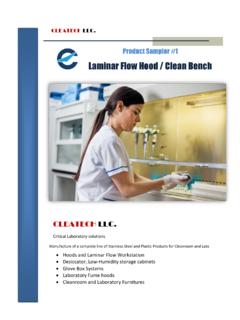Transcription of OPERATING INSTRUCTION TWO-TEMPERATURE …
1 May 2005 OPERATING INSTRUCTIONTWO-TEMPERATURE HemaCool Advanced Technology Blood Product Storage and TransportRefrigerator/FreezerModel HMC-MIL-1 NSN 4110-01-506-0895 McEwen RoadDayton, OH : (937) 312-0114 Fax: (937) 312-1277E-mail: OPERATING InstructionRevision 2 HemaCool OPERATING InstructionTOC-i/TOC-ii blankREV 2 Table of ContentsPageChapter .. 1-1 Section Familiarization .. Description .. Specifications .. Specifications .. Operation .. 1-5 Section Controls and Displays .. Panel .. and Control Panel .. and Alerts .. Alarm .. Display .. Status and Charging .. Status .. Modes.. States.. Ports .. Program .. 1-21 Chapter .. and Precautions .. Care .. Procedures .. of Mode .. 2-9 Chapter Maintenance and Troubleshooting .. 3-1 Section Troubleshooting .. 3-1 Section Maintenance Task Details .. Fuses.. Intake Filters .. Lid Gaskets.
2 For Moisture Accumulation .. for Battery Terminal Corrosion .. Batteries Charged .. Repair and Maintenance .. 3-10 Chapter .. 4-1 Chapter .. 5-1 Section Specifications .. HMC-1-MIL.. 5-1 Section .. 5-2 Appendix A. Schematics and Board Layouts .. A-1 Control Motherboard Layout .. A-1 Control Motherboard Schematic (Sheet 1 of 2) .. A-2 Control Motherboard Schematic (Sheet 2 of 2) .. A-3 Display Circuit Board Layout.. A-4 Display Circuit Board Schematic.. A-5 HemaCool OPERATING Instruction1-1 REV 2 CHAPTER 1. INTRODUCTIONS ection I. System Familiarization HemaCool is a conventional liquid/vapor-phase refrigerator with a number of special enhancements: (1) HemaCool employs vacuum insulation panels to decrease the power required to regulate temperature in a given environment, to increase holdover time when energy sources are lost or disconnected, and to increase internal temperature stability.
3 (2) In the COOL mode (4 C (39 F) set point), the unit prevents payload freezing in sub-zero environments by applying heat, rather than cooling. (3) The unit's control system works with a number of different power sources without special adapters. This power system includes internal batteries that allow the HemaCool to operate for a time without external power (see Operational Specifications, Paragraph 1-4). (4) The HemaCool includes integral monitoring and logging of payload compartment temperature and battery charging state. (5) The HemaCool's internal design is arranged to accept baskets for holding blood bags (or fresh frozen plasma bags when the unit is OPERATING in freezer mode).(6) Small internal fans help circulate cooling air, to maintain uniform HemaCool is designed to preserve liquid or frozen blood products and medical supplies. HemaCool provides exceptional field storage through its combination of superior insulation technology and temperature controls, based on microcontroller solid-state electronics.
4 HemaCool is portable and self-powered, utilizing internal batteries. The system will accept electrical power from multiple sources, , 12-28 VDC from batteries or other DC sources at the DC power input, or from a wide range of grid power standards (any combination of 100-250 VAC and 50-60 Hz line frequencies) at the AC power the unit is fully stocked with conditioned contents and no power is applied (unit off), it will take more than 2 hours for the internal payload temperature to rise from 4 C (39 F) to 6 C (43 F) in an ambient temperature of 49 C (120 F).(1) The HemaCool will perform in either the COOL or FREEZE mode.(a) In the COOL mode (4 C (39 F)), the unit, provided its two internal 21-amp-hour batteries are properly charged, will maintain a temperature range of 1 C (34 F) to 6 C (43 F) for more than 24 hours at 24 C (75 F) ambient EQUIPMENT DESCRIPTIONHemaCool OPERATING Instruction1-2 REV 2(b) In FREEZE mode (-22 C (-7 F)), the unit, provided its two internal 21 amp-hour batteries are properly charged, will keep blood products frozen for more than 8 hours, at an ambient temperature of 24 C (75 F).
5 Freeze mode operation does, however, reduce the battery-powered hold time. (See Operational Specifications, Paragraph 1-4).(2) For additional payload security, the HemaCool is also equipped with an internal heater that will prevent a refrigerated payload from freezing if the unit is in an environment that is below 1 C (34 F), but no lower than -20 C (-4 F). standard default temperature scale setting for the HemaCool is Celsius ( C). NOTEThis manual assumes that when viewing the HemaCool , the front is the side with the internal lid latches. The display screen is on the left when viewed from the front. Viewed from the front, the compressor and electronics compartment is on the left side of the machine, while the batteries are under the cover panel on the right HemaCool is ergonomically designed for quick response operation in the world s harshest OPERATING environments and incorporates the following features.
6 Figure 1-1 illustrates these Mil-Spec Case (1). tie-down-rated carry handles for two- or four-person carry transportation (2). positive locking latches for secure storage and transport (3). panel for control and connection to external power sources (4). and control panel for operator interface (5). load/unload baskets that allow convection around packs for even cooling (6). panel insulated lid (7). cover panel to store all required cables and accessories (8). HemaCool can be stored in temperatures from -30 C (-22 F) to 65 C (149 F). 1-2. FEATURESHemaCool OPERATING Instruction1-3 REV 2 Figure FeaturesHemaCool OPERATING Instruction1-4 REV 2 volume:2 cubic feet ( liters) bay dimensions:13 in. ( cm) H x 14 in. ( cm) W x 18 in. ( cm) in. ( cm) H x 21 in. ( cm) W x in. ( cm) weight:142 lbs ( kgs) temperature regulation:COOL mode: C 1 C (39 F 2 F)FREEZE mode: -22 C +0/-6 C (-7 F +0/-11 F) in 30 C (86 F) ambient or lower power consumption during COOL mode startup:<40 W at room temperature (55 W at 40 C (104 F)) ambient power consumption for COOL mode storage only: <20 W at 40 C (104 F) ambient capacity:40 x 450 ml units or 60 x 250 ml :12 volt, 42 amp-hour total capacity Set contains two 21 amp-hour batteries Battery weight (total): 27 lbs ( kg) Provide 24 hours of operation in storage only HemaCool accommodates a variety of power sources: Batteries or external 12-28 VDC to auxiliary input AC power from grid or generator Grid power required: Any combination of 100-250 VAC and 50-60 HemaCool employs environmentally safe R 134A HemaCool is designed to be operated in temperatures from -20 C (-4 F) to 49 C (120 F).
7 HemaCool can be stored in temperatures from -30 C (-22 F) to 65 C (149 F). 1-3. PHYSICAL SPECIFICATIONS1-4. OPERATIONAL SPECIFICATIONSHemaCool OPERATING Instruction1-5 REV 1-2 is a functional block diagram of the HemaCool as described normal operation, the evaporator temperature sensor (Figure 1-2) is monitored by the control board processor chip, which compares its output to an internal look-up table. This table lists the evaporator temperatures that the compressor should turn on and off to maintain the temperature selected on the power panel. The on/off function is performed by an optically isolated MOSFET switch on the control board that is routed to the compressor through the power board. This switch acts in place of the conventional thermostat switch to tell the compressor driver to run the compressor and fans. compressor can operate in two speed settings: slow or fast. Each time the compressor is started, it runs in slow speed.
8 If the compressor runs continuously for 2 minutes, and the temperature has still not reached the desired target, the compressor switches to fast speed. It continues to run in fast speed until it cycles, or is turned the control temperature selection is changed, it tells the control board processor to use a different look-up table. thermal contact between the evaporator and the payload is made through air circulated by the internal fans, it is imperfect. In above 0 C (32 F) ambient temperatures , this means the evaporator runs cooler than the payload temperature. The only exception is when the heater operates to prevent payload freezing in outside ambient temperatures of below 0 C (32 F). of the temperature difference between the payload and the evaporator, as well as to have faster response, the temperature sensor for the evaporator is separate from the payload compartment temperature sensor and mounted directly on the payload compartment temperature sensor is monitored by the microprocessor to alert it to any failure of the temperature regulating system and to generate the temperature readout in the display.
9 Temperature information supplied to the data logger is provided by the payload, evaporator, and ambient sensors. processor takes a new reading of the temperature (and also of battery voltage) every seconds. It averages eight readings before updating the display. This means the display updates every 10 seconds. the unit is OPERATING on DC from its batteries or DC auxiliary power, the internal and external fans operate only when the control board operates the compressor. AC power is available, the AC to DC converter runs constantly to keep the batteries charged, and the condenser coil blower runs constantly to exhaust heat from the converter. The internal fans are switched through a magnetic reed switch operated by the payload compartment lid. If the lid is open, the internal fans are turned off to prevent the mixing of outside air with the control board determines which power source is used to operate the unit.
10 This ensures the AC supply takes over for the batteries and charges them during operation. A manual temperature or other change may not be displayed for 10 NORMAL OPERATIONHemaCool OPERATING Instruction1-6 REV 2 Figure 1-2. Functional Block DiagramHemaCool OPERATING Instruction1-7 REV 2 Section II. Operator Controls and Displays The power panel (Figure 1-3) in the compressor and electronics compartment has input connectors for auxiliary DC power and for an AC power cord. The AC power connector is fused by two fuses on this panel. Two fuses are employed because the unit will operate on either 115 VAC or 230 VAC. Operation on 230 VAC requires both non-ground leads to be fused. 1-6. POWER PANELITEMDESCRIPTIONFUNCTION1AC Power Source ConnectorConnection to AC external power sources2DC Power ConnectorConnection to DC power sources3 Line FusesOperator replaceable overload protectionFigure PanelHemaCool OPERATING Instruction1-8 REV 2 The display and control panel (Figure 1-4) contains the LCD and LED displays and operator controls.








